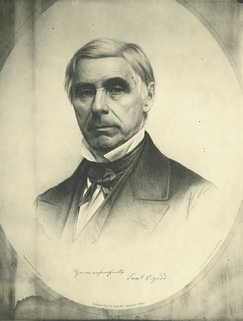resisting slavery
Rev. Samuel Osgood
In addition to lending his house to fugitive slaves, Osgood served as a member of the Hampden County Anti-Slavery Society . The society represents one of the earliest efforts in the growing campaign to abolish slavery. Although radical abolitionists like William Lloyd Garrison of Boston frequently overshadowed local efforts and discussions of slavery, the minutes of the meetings of the Hampden County Anti-Slavery Society reveal how opposition to the South's "peculiar institution" took hold in cities and towns across New England and the nation.
In the minutes of a March meeting of the society in 1831, those present declared "that the general [plight] of slaves is one of import to all the inhabitants of the United States, & in its present position before the humblest mind, demands immediate & thorough investigation, till every man is convinced what is the right method for its removal." At this stage in the abolitionist movement, strategies and tactics were still being argued. Some favored publicity campaigns aimed at the hearts and minds of the citizenry, while others supported efforts to ridicule southern slave owners and pressure politicians to make changes in the law. As abolitionists put forth moral, political and economic arguments against slavery, Reverend Osgood recognized that effective pressure upon federal politicians and southern slave owners remained a distant goal of the movement. So he guided the efforts of the local anti-slavery society toward educating northerners and southerners alike on the evils of slavery. Meanwhile, he continued in his efforts to shepherd escaping slaves to freedom via the Underground Railroad.
Mirroring the expansion of the national abolition movement , the Hampden Anti-Slavery Society grew during the 1830s, and in 1835 group members voted to hold quarterly meetings to discuss issues pertaining to slavery. In a January 1835 meeting, members passed a resolution declaring "that slavery is under all circumstances a sin against God and the rights of Humanity... and in our judgment there is a solemn obligation resting upon the north" to bring an end to the system that enslaved hundreds of thousands of African-Americans.
Springfield served as a crucial stop along the Underground Railroad and developed an active abolitionist community of both black and white residents. In the mid-nineteenth century, abolitionists and anti-slavery collaborators faced grave risks to themselves and their families. The story of Reverend Samuel Osgood illustrates the commitment many had, despite the dangers, to bringing slaves one step closer to freedom.